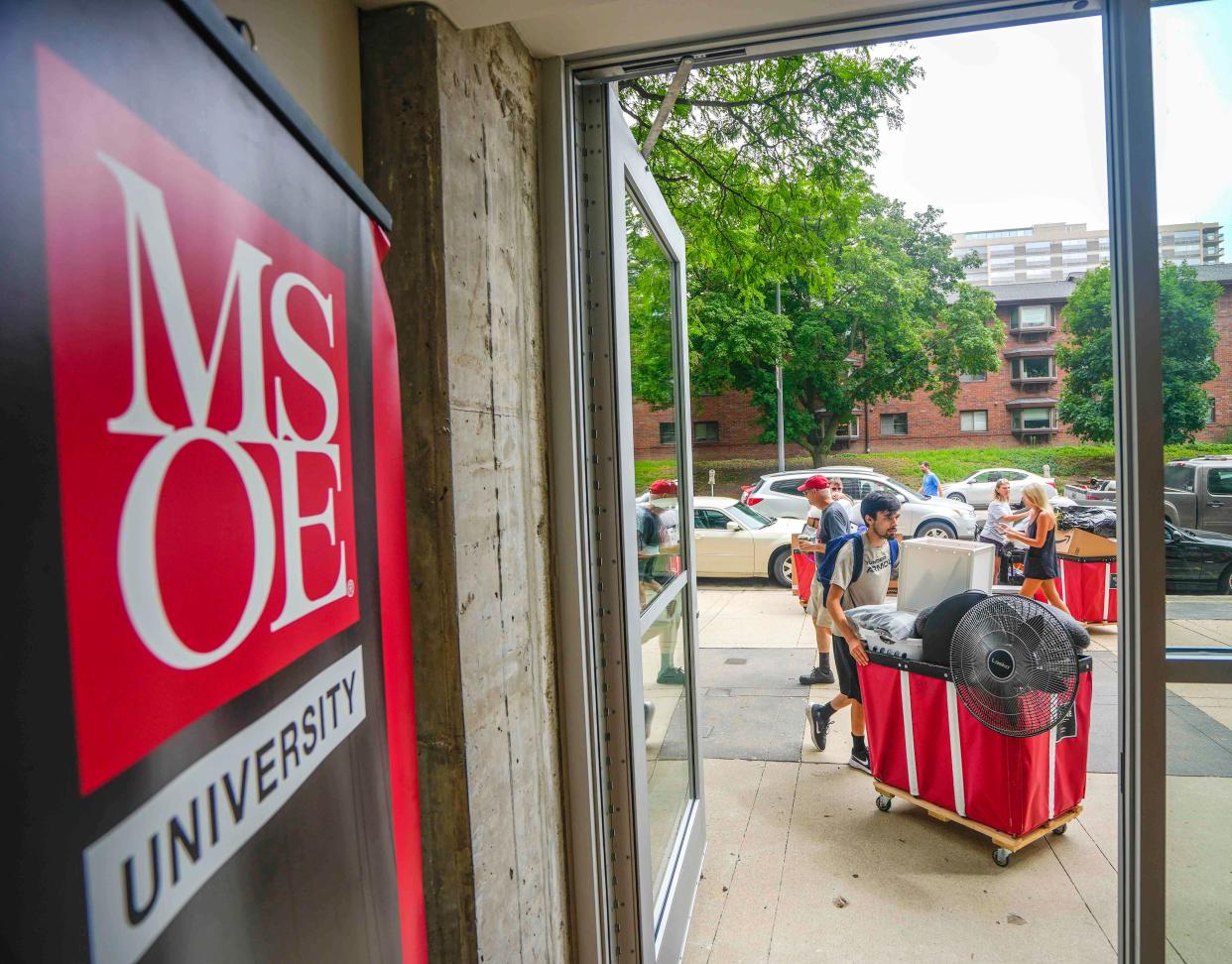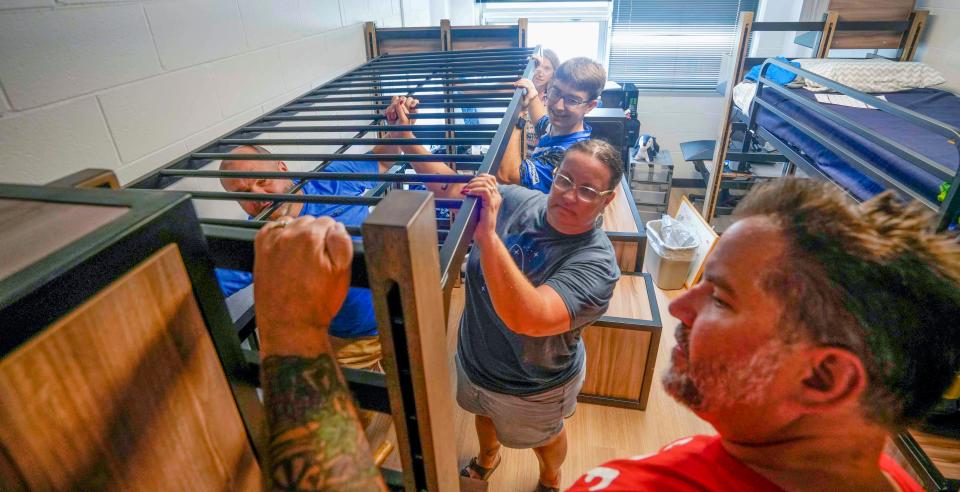Milwaukee School of Engineering ditches quarter system for semesters. Will it be better for students?

It's back-to-school season for Wisconsin colleges and universities, a time of rolling red carts, emotional good-byes and excitement.
The move-in scene at the Milwaukee School of Engineering last week felt familiar, but this school year will stand out in one key way: After decades of operating on the quarter system, the school and its nearly 3,000 students are switching to a semester schedule.
What may sound like a small shift overlooks the importance of the academic calendar on campus life. It dictates the rhythm of a university, signaling when students silo themselves away to study, when professors plan exams and when tuition bills are due. Different schedules can help or hinder learning, and play a role in internships, study abroad and transfer opportunities.
Why did MSOE move to semesters?
Many students, faculty and alumni appreciated MSOE's quarter system, which was broken into three 10-week terms instead of two 15-week semesters.
But semesters brings some built-in advantages, said Eric Baumgartner, MSOE's executive vice president of academics. The quarter system leaves little time to get acclimated to classes. A sick student who misses a week of classes loses 10% of the course material.
"If there's any sort of hiccup along the way, especially early in the term, you just don't have a lot of time to recover," Baumgartner said. "So we think (semesters) will have a positive impact on student retention and persistence to graduation."
The switch may also ease the transfer process, he said. About 100 to 120 students transfer to MSOE annually. and the credit conversion process can be tricky because most come from schools with semester schedules.
Off-campus learning opportunities, like internships and study abroad programs, will also align better under the new calendar, Baumgartner said. MSOE couldn't accommodate a co-op program on the quarter system but now it can.
What does research on different calendar systems show?
In the first comprehensive analysis of how students are affected when schools switch from quarters to semesters, economists found little evidence to support the claim of increased internship employment when schools switched from quarters to semesters. The researchers also found the move to semesters actually decreased the probability of on-time graduation.
But Baumgartner noted that some of the study's data came from a large public state system where students might not be admitted into their major until sophomore year. He said MSOE is confident the calendar switch won't affect students' time to graduation because they are directly admitted to their program.
He called the 2022 study "intriguing" and "commendable" but difficult to "draw an apples-to-apples comparison" because MSOE is a small, private institution.
"We remain confident that the conversion from quarters to semesters is coming at the right time for MSOE," Baumgartner said.
When did Milwaukee School of Engineering decided to move off of quarter system?
Conversation about the calendar began in 2017.
An MSOE task force of faculty and staff studied options. The group found fewer than 10% of institutions similar to MSOE were still operating on a quarter system, down from 25% in the 1980s. It recommended shifting to semesters in 2019.
What feedback has MSOE received on the switch to semesters?
When alumni heard about the switch, "some were happy we were making this move, and some weren’t so happy," Baumgartner acknowledged. "They thought the 10-week quarter was magic (and) was our secret sauce that produced highly capable, outstanding graduates. The task force disagreed with that assumption."

Student opinions on the new calendar are a "mixed bag," incoming MSOE senior Mike Christie said. He thinks the move will ultimately be a benefit and said his adviser "ran around like a chicken without its head" to ensure he and others remained on track to graduate.
What was involved in moving MSOE from quarters to semesters?
Departments had to determine what material to keep and cut from their programs. For example, classes taught over two quarters, or 20 weeks, had to be converted into 15-week classes. Classes taught over three quarters, like Calculus I, II and III, had to be split differently. Every course had to be redesigned.
Chris Taylor, a professor in the electrical engineering and computer science department, worried about the workload his colleagues would bear. He addressed it in a classic MSOE way: by developing a software program.
Four students developed a prototype as part of a yearlong class project. Taylor and a colleague refined the Semester Transition Advising Tool for campuswide use.
Advisors uploaded each student’s course history into the program, and the system mapped out which new classes were needed based on rules written into the code. The program is interactive, allowing advisers to drag and drop different courses into different semesters. Students can see how much work it would be to add a minor or switch majors.
The program saved advisers an untold number of hours they would have been spent manually creating individual transition plans for each student.
It's a far cry from the Excel spreadsheets, paper and pencil used during the 2011 transition from quarters to semesters at Ohio Northern University, where Baumgartner previously worked.
Has MSOE encountered issues in calendar switch so far?
Registration last spring for fall classes had no major scheduling meltdowns, Baumgartner said.
"I think that says a lot," he said. "The quiet says a lot."
But he's not celebrating just yet.
"The registrar’s office will be living this for the next three years until the last class of quarter-system students graduate," he said. "We haven't crossed the finish line."
Do any other Wisconsin universities not operate on semesters?
MSOE's shift appears to leave just one Wisconsin institution, Lawrence University, operating on a non-semester schedule. Since 1962, the Appleton schoolhas run on trimesters, which are similar to quarters and offer three 10-week periods.
While the trimester schedule comes up in conversations with prospective students and faculty, Lawrence University Provost Peter Blitstein said there's no active discussion or study underway about shifting to a semester schedule.
One of the main advantages Blitstein sees with trimesters is students and faculty alike handle fewer courses at the same time, allowing more devoted attention to learning. He also said trimesters work well for study abroad programs.
Unlike MSOE's winter quarter, which started in early December and included a holiday break before continuing in January, Lawrence's winter trimester begins in January so students can go abroad in the fall but not fall behind in their classes because they still have their the winter and spring trimesters on campus.
"Any academic calendar has strengths and weaknesses," Blitstein said. "Because the semester calendar dominates at the university level and obviously at high schools, it seems natural to have that calendar but that doesn’t mean there aren’t other suitable options."
Contact Kelly Meyerhofer at kmeyerhofer@gannett.com. Follow her on Twitter at @KellyMeyerhofer.
This article originally appeared on Milwaukee Journal Sentinel: MSOE moves from quarter system to semester calendar

